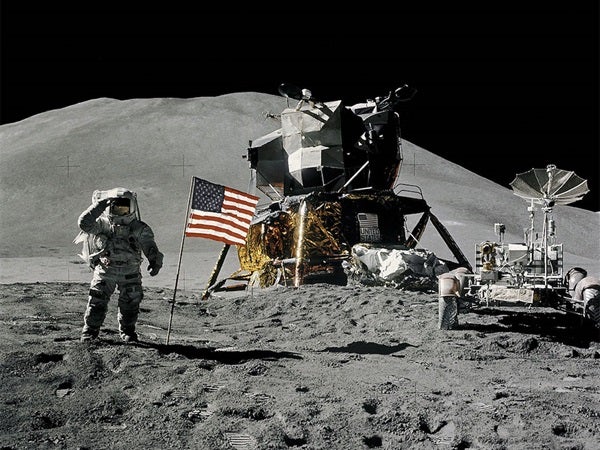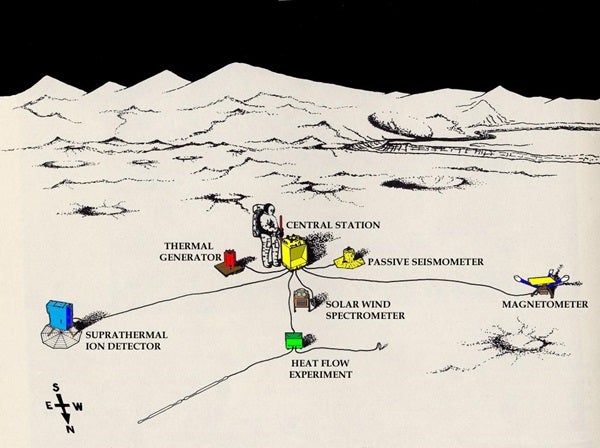Both the United States and the Soviet Union had something to prove during the 1960s. Throughout this time, the two rivals wanted to demonstrate the superiority of their political system and their military. Short of all-out war, however, what could they do to prove dominance? A look to the sky provided an easy answer: Be the first country to send humans to the Moon. That would show the world who was top dog.
Of course, the Americans won the space race when Apollo 11 landed July 20, 1969. But we couldn’t just set down on the surface, take one small step, and then pack up and leave for good. No, NASA was infused with scientists who demanded more — and got it. Each of the six Apollo missions that landed on the Moon carried an array of science experiments designed to tell us about our satellite and its environment. The Moon rocks the astronauts brought back to Earth deservedly received the most attention, but the other experiments proved their worth as well.
Apollos 12, 14, 15, 16, and 17 all carried an Apollo Lunar Surface Experiments Package (ALSEP in NASA-speak). This sophisticated suite of instruments took about two hours to set up, which is why Apollo 11 didn’t bring one — that mission’s single moonwalk didn’t allow enough time. Instead, Apollo 11 brought a simpler version known as the Early Apollo Surface Experiments Package, or EASEP. It included just two experiments: a passive seismometer and a dust collector. The seismometer recorded 100 to 200 micrometeorite hits before it failed August 27, 1969, exactly one month beyond its design lifetime.
The five ALSEPs were not identical. In fact, no single experiment made an appearance in all of them. The only common denominator was the central hub, or station. It supplied 70 watts of power to the instruments through the radioactive decay of plutonium and provided two-way communications with Earth so the package could receive commands from home as well as relay the data it collected.
The experiments ran the gamut of studying the composition of the extraordinarily tenuous lunar atmosphere; exploring the charged particle environment and solar wind; measuring the amount of accumulated dust, which was much less than expected; and probing the Moon’s weak magnetic field. An instrument designed to study the Moon’s heat flow found that the temperature of the surface layer dips to –323 degrees Fahrenheit (–197 degrees Celsius) at night but rebounds to 185 F (85 C) at its daytime peak. At a depth of 5 feet (1.5 meters), however, the temperature remains a constant –4 F (–20 C).
Perhaps the most important ALSEP instruments were their seismometers. Some missions carried passive seismometers scientists used to study the Moon as a whole. These detected the tiny vibrations caused by meteorite impacts, distant moonquakes, spacecraft impacts, and man-made explosions. They sensed meteorite impacts daily and an average of two moonquakes per month. Their observations revealed a picture of the Moon’s interior in the same way that earthquakes expose our planet’s insides. The results show the Moon’s core extends only 20 to 25 percent of the way to the surface. The seismometers also found that the Moon rings like a bell when it suffers a strong hit, as it did when NASA purposely crashed the Apollo 12 lunar module’s ascent stage into the surface. Once shallow moonquakes start up, they found, the vibrations last 10 minutes or more — much longer than similar events on Earth, which typically die off in a minute or less.
Apollos 14 and 16 carried active seismic experiments (and Apollo 17 had a similar instrument) designed to study the Moon’s reaction to explosive charges placed by the astronauts. Some of these were akin to a shotgun blast, but the crews of Apollos 16 and 17 also left behind mortar shells that were detonated remotely once the astronauts left. The experiments revealed that the top part of the lunar crust is highly fractured, a result of the prolonged meteoritic bombardment of the Moon.
The ALSEP experiments kept working for the most part until September 30, 1977, when NASA permanently shut them down due to budget cuts. But that wasn’t the end of Apollo lunar science. Apollos 11, 14, and 15 each carried a Lunar Ranging Retro-Reflector — not officially part of ALSEP — designed to reflect laser signals sent from Earth back home to allow scientists to measure the distance between our two bodies to within 0.04 inch (1 millimeter). All three still function. Astronomers have used them to learn that the Moon is spiraling away from Earth at 1.5 inches (3.8 centimeters) per year. The observations also show that the universal force of gravity is highly stable, with no detectable changes over the past 50 years.
All in all, it’s not a bad legacy for a program that started in the midst of the Cold War.
For much more on the Apollo missions, make sure to check our special Celebrating 50 years of Apollo webpage, where you’ll find everything you want to know about the equipment, plans, and people that made the Apollo missions possible.











